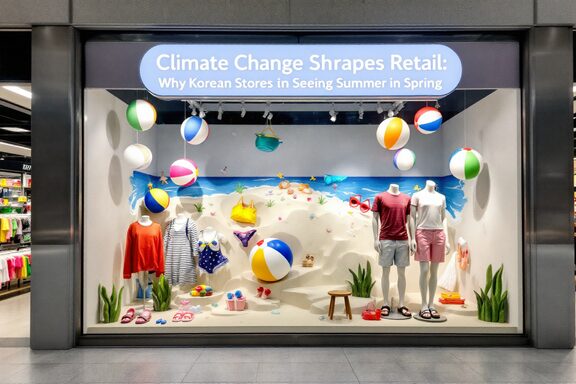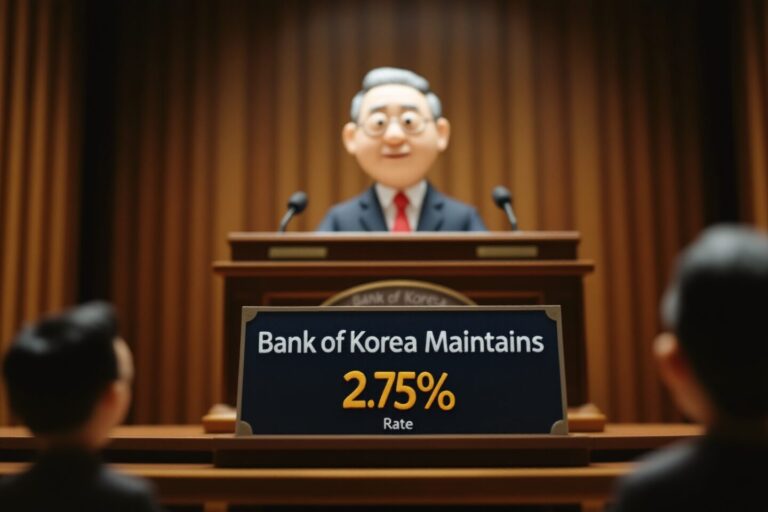Climate Change Reshapes Retail: Why Korean Stores Are Seeing Summer in Spring
The traditional four-season retail model is crumbling as unprecedented climate shifts force major Korean retailers to rethink their entire business strategy. Climate change is dramatically altering consumer shopping patterns, with spring fashion sales stagnating while summer appliance demand skyrockets months ahead of schedule. This fundamental disruption is forcing retail giants to establish climate task forces and reimagine their seasonal inventory planning.
Weather Shifts Disrupting Traditional Shopping Seasons
Climate change is creating a measurable impact on retail sales patterns, undermining established seasonal merchandising strategies.
- Lotte Department Store reported flat year-over-year performance in fashion categories during February and March 2025
- Shinsegae and Hyundai Department Stores showed minimal growth of just 0.9% and 0.2% respectively in spring fashion items
- Industry analysts attribute the sluggish performance to both weakened consumer sentiment and unusually cool spring temperatures
Summer Electronics Sales Surge Prematurely
Anticipation of extreme summer heat is driving unprecedented early-season demand for cooling appliances.
- The Korean Meteorological Administration forecasts significantly above-average temperatures for summer 2025
- Lotte Himart has recorded a remarkable 50% increase in air conditioner sales compared to the same period last year
- Electronics manufacturers Samsung and LG report air conditioner sales increases of 51% and 60% respectively, pushing production lines to 100% capacity
Retailers Form Climate Task Forces
Major retail chains are establishing dedicated teams to address the business implications of climate change.
- Hyundai Department Store has formed a climate change task force with key fashion partners to reassess sales strategies
- The initiative is exploring increasing summer inventory allocations while reducing traditional spring and fall merchandise
- This represents a significant departure from conventional retail planning models that have remained relatively stable for decades
Flexible Inventory Management Becomes Critical
Leading retailers are developing more responsive inventory systems to match rapidly changing consumer demands.
- Lotte and Shinsegae are modifying their traditional four-season product strategies to respond more dynamically to climate fluctuations
- Real-time weather forecasting data is increasingly integrated into inventory planning systems
- Product development cycles are being compressed to allow faster response to emerging weather patterns

The retail landscape in Korea is undergoing a fundamental transformation driven by climate change. As traditional seasonal boundaries blur, retailers who can rapidly adapt their merchandising and inventory strategies will likely gain significant competitive advantage. The question remains: will these adaptations be enough to offset the financial impact of increasingly unpredictable consumer behavior?
Keywords
Climate change, retail trends, seasonal shopping, Korean department stores
Hashtags
#ClimateRetail #KoreanRetail #RetailTrends
한국어 요약
- 기후 변화로 인해 롯데백화점, 신세계, 현대백화점의 2~3월 봄 패션 판매가 부진한 반면, 여름 가전제품 판매는 크게 증가함
- 기상청의 올해 더운 여름 예보에 따라 롯데하이마트의 에어컨 매출은 50%, 삼성전자와 LG전자의 에어컨 판매는 각각 51%와 60% 증가
- 현대백화점은 패션 협력사들과 기후변화 태스크포스(TF)를 구성하여 여름 상품 물량 증가, 봄·가을 상품 감소 등 전략 재검토 중
- 롯데와 신세계도 기존 4계절 상품 전략을 수정하여 기후 변화에 더욱 탄력적으로 대응할 계획을 수립 중







